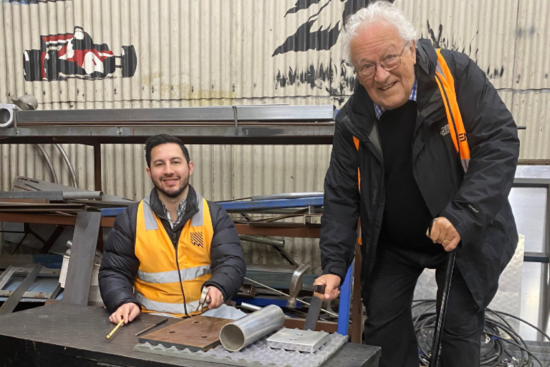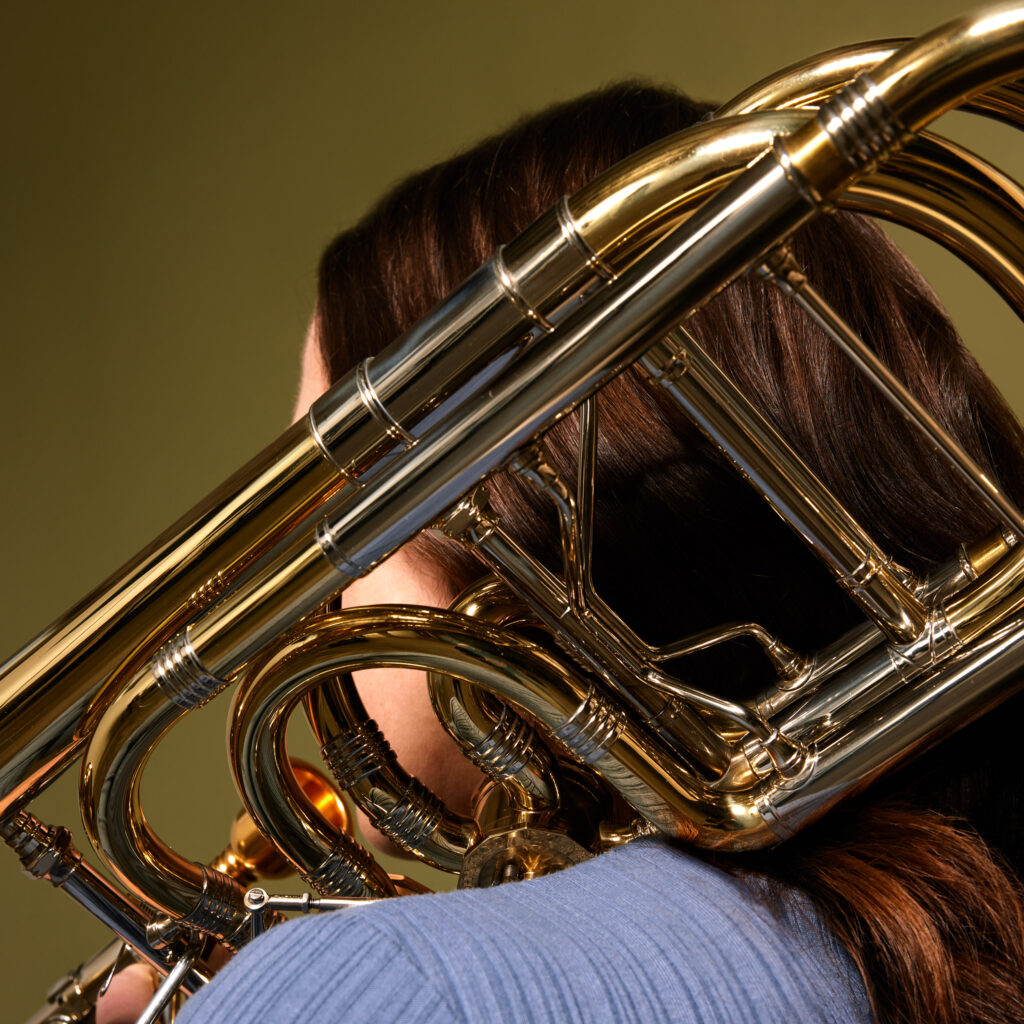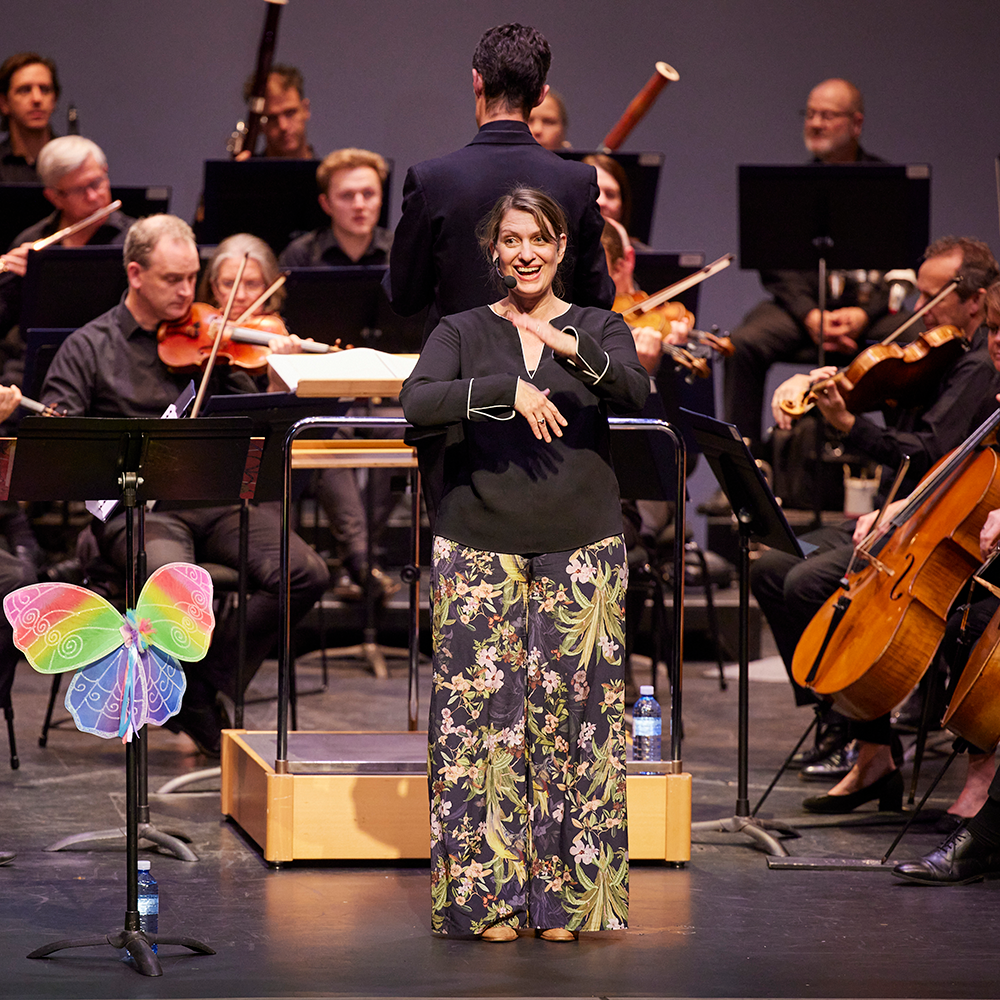From SA Power Networks workshop to the ASO stage – Searching for the perfect anvil
- Meet the Artists

Symphony Series 5 – Spellbound sees ASO Percussionist Sami Butler play the anvil during Wagner’s The Ring Without Words. For any other piece the ASO has existing anvils to use, but in the case of the Wagner, we needed specifically pitched anvils. Here Sami and ASO Conductor Laureate Nicholas Braithwaite tell us what this unusual instrument is, and how they went about searching for the perfect anvil with the help of ASO supporter SA Power Networks.
What is an Anvil?
Sami In the way of being a percussion instrument, an anvil is simply a piece of metal that we strike with hammers or sometimes with mallets or triangle beaters. The ideal anvil would have the capabilities to resonate and offer an appropriate spread of tones and overtones for its given musical context, or be dampened with a towel or cloth to create a shorter sustain or even just a dry ‘tink’. Some companies manufacture anvils and sell them specifically as an instrument but a lot of the time percussionists will head out into junk yards, workshops and garages in search of scrap pieces of metal. We are incredibly fortunate at the ASO to have a beautiful anvil (and complementary mallet) from the 1930s made by the Leedy company. It was originally purchased and played by Richard Smith, former ASO Principal Timpanist and one of Australia’s most iconic percussionists and pedagogues, and has lived in our percussion inventory ever since. Only slightly less ceremoniously, I once found a cold chisel in my grandfather’s shed that sounded pretty neat, so he let me have it and I have since performed with it a few times. Sadly it didn’t come with a complementary boutique mallet, but the hammer from my orange IKEA toolset has worked just fine so far!
Is an Anvil a proper instrument?
Sami I guess it really depends on what your definition of a ‘proper instrument’ is! It is certainly more than just a gimmick. Even though you might not find them in a Brahms or Beethoven symphony, anvils have appeared in numerous composers’ works with notable examples besides the Wagner being Verdi’s Anvil Chorus from Il Trovatore, Walton’s Belshazzar’s Feast and Copland’s third symphony. There have also been many instances of composers utilising anvils for film scores, some of which we have played live in the ASO. I remember playing anvils in John Williams’ soundtrack for Star Wars: A New Hope when the Tusken Raiders are preparing to ambush Luke! Somehow it was just the perfect colour for that scene. Famously for percussionists, Varese utilised a pair of anvils for his mammoth percussion ensemble piece Ionisation which is regarded as one of the greatest and most important works for percussion. Outside of the orchestral/classical realm, if anyone recently watched the Beatles documentary directed by Peter Jackson, then you might have seen the anvil being recorded on Maxwell’s Silver Hammer!
How does the anvil feature in this concert?
Sami In Wagner’s Rheingold the Nibelungs work in the subterranean sweatshop hammering on the Rhine gold. The sound the anvils make is fascinating and ghostly. When seated in the auditorium, the clanging seems to be coming from all directions and you can picture the Nibelungs slaving away under the harsh scrutiny of Alberich. It is a magical sound.
Three percussionists play the three anvils during The Ring Without Words, what does this involve?
Sami: Sadly I won’t get to play the anvils as I’ll be playing the second timpani part for the Wagner! However, all three of the percussionists will actually play anvils for our performance from various offstage locations. Once we are in the Town Hall we will be able to test out our exact approach, but straight away I would assume they would be playing very loudly and most likely all be wearing earplugs!
ASO called upon their partner SA Power Networks to see if they had any metals in their workshop so that the ASO could turn the scrap metal into anvils for the performance. What did you find?
Nicholas Braithwaite Kylie and Phill of SA Power Networks were incredibly helpful and showed us many pieces of metal that we could hit to see if they produced the sound we need for this concert. Happily we were successful and we have found what we think will provide exactly the right sound.
How many anvils exist in Australia and where would the ASO normally get the anvils from for the performance?
Sami There are probably loads of anvils around Australia. Definitely, if we include any resonant piece of metal! Normally the ASO would just use our own anvils for any other piece. But in the case of the Wagner, we have gone out of our way with a little help from our friends at SA Power Networks to find specifically pitched anvils
How did you find the anvils that will be used during this concert?
Sami In the past when I’ve gone out into the ‘real world’, usually people think I’m crazy when I start hitting stuff in their shops. I was told off by a Bunnings assistant a few years ago in the garden section when I was whacking flowerpots with a vibraphone mallet. And once at Harris Scarfe I noticed a few of the guys behind the counter looking very weirded out when I was tapping a rice bowl with a pencil to see if I could get it to the right pitch. So it was a nice change when SA Power Networks actually offered to help Nick and I in our hunt for instruments! It was a thoroughly enjoyable process and I’m so thankful to Kylie and Phill for taking us around to the various workshops to test out all of their various pieces of metal. In the end, we found three contrasting anvils; one cylinder, one small square plate and one large, incredibly heavy rectangular plate! All of the anvils are approximately a concert F, all in different octaves.
Thanks to ASO partner SA Power Networks, Conductor Nicholas Braithwaite and Percussionist Sami Butler were able to find some recycled materials to use as anvils in the performance of Symphony Series 5 – Spellbound.
These pieces of metal are normally used by SA Power Networks within their substations in their high voltage equipment. Substations are an essential part of the network providing power to homes and businesses. Can you explain what these three pieces of metal actually are?
Kylie, SA Power Networks The more technical explanation is the cylinder is a joint for a 66Kv busbar, the aluminium plate is welded to a 66Kv busbar to connect to other high voltage equipment (like circuit breakers) and the large steel plate is a support component for a busbar! In power-intensive electrical applications, a busbar is a critical element for conducting significant current levels between functions within the assembly. Busbars may be used in any number of configurations, ranging from vertical risers to bars within a distribution panel, or part of an industrial process.
SA Power Networks supports the ASO as their Learning Program partner, Kylie Kerrigan SA Power Networks Sponsorship Manager explains the relationship:
SA Power Networks have been a long term partner of the ASO’s Learning Program to provide students with the many benefits a music education can provide, particularly schools that may not have music as a central part of their curriculum or the ability to afford excursions themselves. Learning a musical instrument and the benefits of music education instil problem-solving skills at all levels and stages of development. SA Power Networks believes in the transformative power of music and are proud to continue our partnership with the ASO’s Learning Program.




